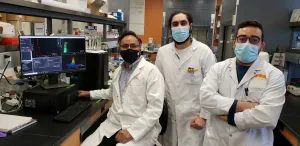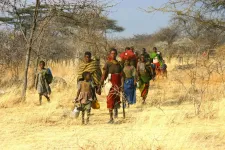INFORMATION:
About Institute of Industrial Science (IIS), the University of Tokyo Institute of Industrial Science (IIS), the University of Tokyo is one of the largest university-attached research institutes in Japan.
More than 120 research laboratories, each headed by a faculty member, comprise IIS, with more than 1,000 members including approximately 300 staff and 700 students actively engaged in education and research. Our activities cover almost all the areas of engineering disciplines. Since its foundation in 1949, IIS has worked to bridge the huge gaps that exist between academic disciplines and realworld applications.
Listening to the call of the wild: Tracking deer movements using sound
2021-01-28
(Press-News.org) Tokyo, Japan -- In the marchland of Japan's Oze National Park, keeping track of the deer population has been a difficult and time-consuming task for the park rangers. Now their lives could get much easier, thanks to a novel technique for tracking deer movements using unmanned listening devices developed by researchers at the Institute of Industrial Science, a part of The University of Tokyo.
Monitoring deer numbers is important in Oze and other national parks in Japan because deer are not native to the ecosystem and can have damaging effects on it. Current methods of monitoring deer populations range from traditional techniques such as counting droppings to photographing deer at night using automated cameras or from above during the day using unmanned aerial vehicles (UAVs). Each of these methods has its drawbacks and limitations--for example, the thick forest cover in some parts of the national park makes it difficult to see the deer from above using UAVs.
"The problem with using recording devices to estimate the size of deer populations in the past was that it was difficult to avoid counting the same deer multiple times--by setting up a grid of listening stations, we are able to triangulate the position of each deer with precision and track its movements," says Tadanobu Okumura, one of the researchers who developed the technology.
The researchers built a prototype listening station which is powered by solar panels and automatically synchronizes its internal clock with a GPS satellite. As the recordings from each of the stations are synchronized, the lag in the time it takes the sound of a deer to reach the recording station can be used to determine its location with precision using a triangulation technique.
"When we tested our prototype in an experimental setting in the playground of The University of Tokyo, we were able to pinpoint the location of a sound within five meters. In a second trial under more realistic conditions in the marshland at Oze National Park, it was possible to locate a sound to within about fifteen meters," explains Kazuo Oki, who also worked on the project. During a two-hour trial in Oze, the system picked up 72 distinct deer calls.
This prototype is a first step toward building a system that can be installed in the wild and monitored remotely. In the muddy wetlands of Oze, this could make the task of counting deer a lot easier.
ELSE PRESS RELEASES FROM THIS DATE:
Leading cardiovascular organizations call for urgent action to reduce air pollution
2021-01-28
Air pollution is a key risk factor for cardiovascular disease, and a major contributor to the global burden of disease. Long-term exposure to air pollution has also been linked to an increased risk of death from COVID-19. This dangerous "triple threat" of air pollution, COVID-19 and cardiovascular disease should be taken seriously, warn major health authorities.
Four leading cardiovascular organizations - the World Heart Federation (WHF), American College of Cardiology (ACC), American Heart Association (AHA) and European Society of Cardiology (ESC) - today released a joint statement urging the medical community and health authorities to mitigate the impact of air pollution on people's ...
Discovery of early plasma biomarkers for Alzheimer's disease
2021-01-28
A Quebec research team has discovered two early plasma markers to detect Alzheimer's disease five years before its onset. The results of this recent study led by the doctoral student Mohamed Raâfet Ben Khedher and postdoctoral student Mohamed Haddad, directed by Professor Charles Ramassamy of the Institut national de la recherche scientifique (INRS), have been published in the prestigious scientific journal Alzheimer's & Dementia: Translational Research & Clinical Interventions (TRCI).
The diagnosis of Alzheimer's disease is usually based on a series of psychometric ...
OSU smoke- and tobacco-free policies grew more popular over time, even among tobacco users
2021-01-28
Support for policies prohibiting smoking and the use of tobacco products on Oregon State University's Corvallis campus grew substantially over a five-year span, especially among tobacco users, a recent OSU study found.
The study, published earlier this month in the journal Preventive Medicine, is unique in its analysis of support for smoke- and tobacco-free campus policies over a long period of time. Most other studies of attitudes toward smoking policies only assess a single point in time.
"Tobacco-free policies are one of the most effective things we can do to reduce the burden of tobacco use, and they are highly supported ...
Gender and spatial behavior
2021-01-28
Navigating, exploring and thinking about space are part of daily life, whether it's carving a path through a crowd, hiking a backcountry trail or maneuvering into a parking spot.
For most of human history, the driving force for day-to-day wayfinding and movement across the landscape was a need for food. And unlike other primates, our species has consistently divided this labor along gender lines.
In new research published in Nature Human Behaviour, scientists including James Holland Jones of Stanford and lead author Brian Wood of University of California, Los Angeles, argue that the increasingly gendered division of labor in human societies during the past 2.5 million years dramatically shaped how our species uses space, and possibly ...
Coronavirus was brought into Russia at least 67 times
2021-01-28
A research team from HSE University and SkolTech, together with experts from the Smorodintsev Research Institute of Influenza in St. Petersburg and the RAS Kharkevich Institute for Information Transmission Problems (IITP), discovered that the SARS-CoV-2 virus independently entered Russia at least 67 times, mostly at the end of February and beginning of March 2020. The vast majority of introductions came from European countries. No cases of introduction from China were registered, which is likely due to the timely closure of borders with the country. Currently, nine local virus lineages are circulating in Russia, which are not present elsewhere in the world. Given that Russia was actively 'importing' the virus from abroad, the researchers have not detected any cases of 'exporting' ...
First hybrid gene therapy shows early promise in treating long QT syndrome
2021-01-28
ROCHESTER, Minn. -- In a new study published in Circulation, Mayo Clinic researchers provide the first preclinical, proof-of-concept study for hybrid gene therapy in long QT syndrome, a potentially lethal heart rhythm condition.
Researchers demonstrated its potential therapeutic efficacy in two in vitro model systems using beating heart cells reengineered from the blood samples of patients with 1 long QT syndrome. They targeted the whole KCNQ1 gene rather than specific LQT1-causative mutations, making this study applicable to all patients with long QT ...
635 million-year-old fungi-like microfossil that bailed us out of an ice age discovered
2021-01-28
When you think of fungi, what comes to mind may be a crucial ingredient in a recipe or their amazing ability to break down dead organic matter into vital nutrients. But new research by Shuhai Xiao, a professor of geosciences with the Virginia Tech College of Science, and Tian Gan, a visiting Ph.D. student in the Xiao lab, highlights yet another important role that fungi have played throughout the Earth's history: helping the planet recover from an ice age.
A team of scientists from Virginia Tech, the Chinese Academy of Sciences, Guizhou Education University, and University of Cincinnati has discovered the remains of a fungi-like microfossil that ...
Deeper insight into how tick spit suppresses cattle immunity
2021-01-28
A tick saliva study reveals immune responses that could lead to better protection for cattle.
Scientists from Hokkaido University, Japan and Universidade Federal do Rio Grande do Sul and Universidade Federal do Rio de Janeiro, Brazil, have revealed that substances in tick saliva activates immune response-suppressing proteins in cattle that facilitates the transmission of tick-borne diseases. The finding was published in the journal Scientific Reports and could help in the development of alternative control strategies.
The Asian blue tick, Rhipicephalus microplus, feeds on cattle, causing skin lesions, ...
Turning food waste back into food
2021-01-28
There's a better end for used food than taking up space in landfills and contributing to global warming.
UC Riverside scientists have discovered fermented food waste can boost bacteria that increase crop growth, making plants more resistant to pathogens and reducing carbon emissions from farming.
"Beneficial microbes increased dramatically when we added fermented food waste to plant growing systems," said UCR microbiologist Deborah Pagliaccia, who led the research. "When there are enough of these good bacteria, they produce antimicrobial compounds and metabolites that help plants grow better and faster."
Since the plants in this experiment were grown in a greenhouse, the benefits of the waste ...
Reconstruction shows increased global warming trends since 1850s
2021-01-28
Earth is warming rapidly, but there is too little observational data in some regions such as the Arctic or high-altitude areas like the Qinghai-Tibetan plateau to adequately and consistently assess temperature variations across the globe. To better understand how temperatures have increased, an international team led by researchers at Sun Yat-Sen University in China has released a newly merged global surface temperature dataset, including reconstructed land and marine measurements from the 1850s to 2018. The study provides evidence that there was a consistent increased warming trend compared with previous estimations, which closely matches the available observational data and updated simulations covering the past two decades.
The approach ...





